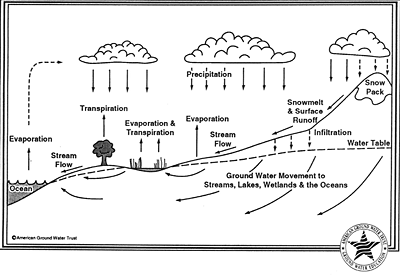
Groundwater is precious. If it becomes contaminated - we can't use it. If it is over exploited we lose the opportunity to achieve sustainability by balancing use and natural replenishment. Knowing where it comes from is an important first step. This month's groundwater topic is a basic education building block that explains origins of groundwater. Questions often asked are: How old is groundwater? Where would it go if we didn't use it? How far does groundwater travel beneath the surface? The basic cross-section drawing, showing the hydrologic system, can help answer some of these questions.
The hydrologic system (sometimes called the hydrologic cycle or water cycle), consists of a series of transfers of water involving the atmosphere, soils, plants, rocks, rivers, lakes, oceans and glacial ice. Water may occur as a liquid, solid (ice) or a gas (water vapor). Water drops are made up of thousands of water molecules, two atoms of hydrogen and one of oxygen (H2O). An individual water molecule may move rapidly through the hydrologic system in a few days or may be in storage (for example as ice or groundwater) for hundreds of years.
Groundwater can occur in pore spaces in some sedimentary rocks (and in sediments such as sands and gravels) and in cracks and fissures in any type of solid rock. Aquifer is the correct technical word to describe water saturated rock formations. Some groundwater is tens of thousands of years old, but most groundwater used for drinking supplies in the US has only been underground for a few months or years. Some groundwater may be recharged from leakage through rivers and lakes, but rainfall and snowmelt soaking into the ground is the principal source of recharge. However, not all rainfall recharges groundwater. Water from light rain is likely to evaporate from soils or used by plants before it has a chance to soak deep underground.
Virtually all groundwater is slowly on the move and will eventually reach the ocean or a wetland stream or lake. Most rivers receive about half their flow from groundwater. How else can rivers flow after weeks and weeks of no rain? In some geologic situations, groundwater may move hundreds of miles from the point of recharge to where it eventually reaches the surface. It is possible to have rock layers with groundwater of recent origin overlying rock layers containing much older groundwater. A well drilled in such geologic situations will contain a "cocktail" of groundwater of different ages.
A copy of this article may be downloaded (for non-commercial use) from the American Ground Water Trust's Web site at agwt.org
Next month, the Trust's groundwater Education Article #2 will show how rivers, lakes and groundwater are connected.




Report Abusive Comment